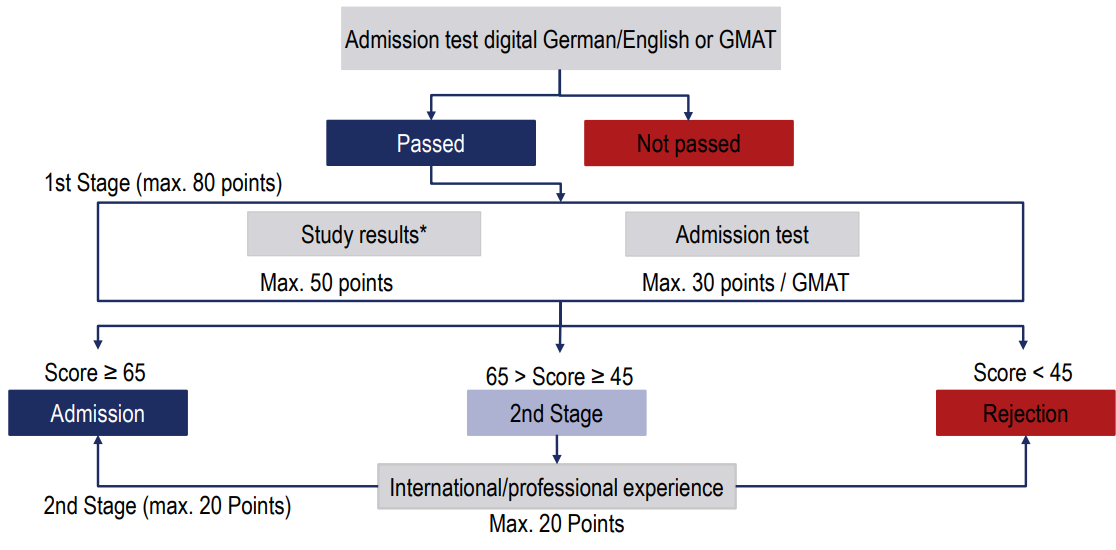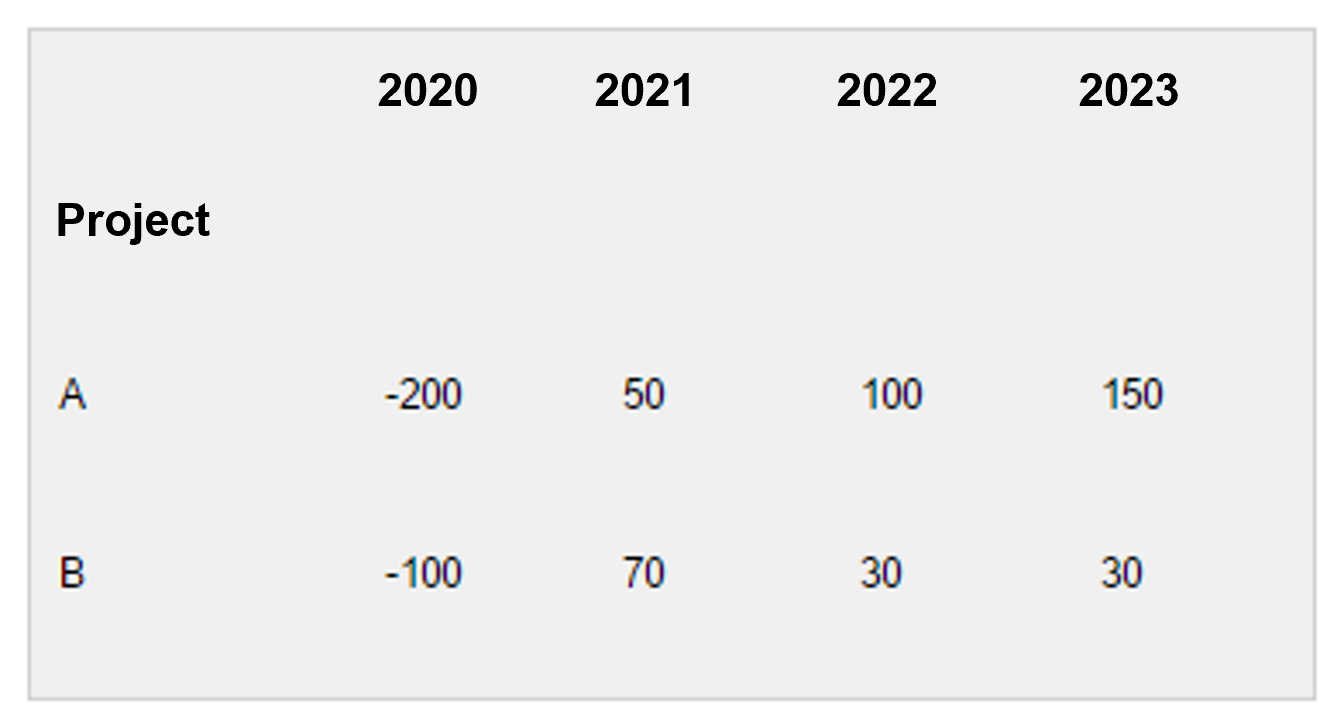Please note: the application period for the winter 2026/27 intake takes place from February 15 until May 31, 2026 via the portal campo.
During the application period, two admission tests will be offered, more information will be published here soon.
Admission requirements
In order to apply for the Master in Management program, applicants must pass our admission test. If this test is passed, i.e. with a grade of at least „sufficient“, the applicant can apply for the study program. As an alternative, the GMAT (at least 600 points in the total score) or GMAT Focus Edition (at least 565 points) can be submitted (results not older than 2 years).
The application deadline is May 31 of every year, the application takes places on the online portal campo (https://www.campo.fau.de/).
Admission criteria
- Academic achievements from the bachelor’s degree program
- Passed admission test or GMAT or GMAT Focus Edition
- Business or comparable relevant work experience (Points for work experience can only be awarded if appropriate evidence has been submitted by the deadline. This evidence must include the period of employment, the exact hours worked per week, and a description of the duties performed. Work experience is measured in full-time equivalents. Explicitly excluded from scoring in the area of work experience are school tutoring and high school internships).
- Qualifying study or work experience abroad (Points for study abroad may only be awarded if supporting documentation is submitted by the deadline. Only stays abroad in a foreign language related to business will be recognized. The evidence must include the exact period of time, a description of the activities (in the case of semesters abroad, for example, an overview of the courses taken abroad) and the country of residence of the stay abroad. Explicitly excluded from the awarding of points in the area of stays abroad are language courses, work and travel activities, au pair activities and school exchanges).
Admission process

In the first stage of the process, applicants are evaluated on the basis of their previous academic performance (max. 50 points) and the result of the admission test (max. 30 points). Applicants who score 65 points or more in the first stage are admitted directly. Applicants who score less than 45 points will be rejected directly. Applicants who score 45 points or more and 64 points or less will be evaluated in the second stage of the qualification assessment procedure on the basis of the criteria „relevant professional experience“ (max. 10 points) and „qualified stays abroad“ (max. 10 points). Applicants who achieve at least 65 points after adding up the points from the first and second stages are admitted to the program. Applicants who remain below 65 points will be rejected.
Please refrain from inquiries in advance regarding an exact crediting of your foreign and work experience in the qualification assessment process. No pre-assessment will be made.
How to apply
Applications must be submitted by 31 May of every year via campo (https://www.campo.fau.de/).
The application must be accompanied by
- Certificate of university entrance qualification (Abitur certificate / A-Levels)
- Proof of university degree or proof of previous examination results including average grade (notarized for international applicants)
- Admission test / GMAT result
- Curriculum vitae in tabular form
If applicable, please enclose:
- Proof of stays abroad
- Proof of work experience
- Language certificate of either German or English language: Proof of A-Levels/Abitur or bachelor’s degree in either German or English; Alternatively: Proof of sufficient German language skills (DSH-2 exam or equivalent certificate) or English language skills (further information can be found in the examination regulatories here).
Advice for the application via the online portal campo
- If you are asked to attach a letter of motivation during the application process, please note that this is not necessary.
- If you have taken a GMAT or the GMAT Focus Edition as an alternative to the admission test, the result of this GMAT / GMAT Focus Edition must be uploaded.
- In case you do not have any stays abroad, please upload a document with a statement that you do not have qualified stays abroad at the position in campo within the application procedure.
General information
The admission tests will take place between March and May 2026, further information will be published beforehand. You can participate in both tests if you like and we will count the better result.
The contents of the admission test are based on the basic courses that are taken as part of a bachelor’s degree in business administration:
- Introduction to business administration
- Accounting, bookkeeping, cost calculations and controlling
- Corporate management
- Investment and financing
- Basics of empirical economic research
The following books, for example, can serve as supporting literature:
- Hungenberg, H., Wulf, T.: Grundlagen der Unternehmensführung, 6th ed.
- Wöhe, G., Döring, U., Brösel, G.: Einführung in die Allgemeine Betriebswirtschaftslehre, 26. Aufl., Munich 2016.
- Coenenberg, A., Fischer, T., Günther, T.: Kostenrechnung und Kostenanalyse, 9th ed.
- Perridon, L., Steiner, M., Rathgeber, A. W.: Finanzwirtschaft der Unternehmung, 17th ed.
- Schlittgen, R.: Einführung in die Statistik, 12th ed.
- Scheffler, W., Köstler, M., Oßmann, S.: Buchführung, 8th ed.
- or equivalents.
Conducting the test
The admission test takes place in written electronic form as an online test with a duration of 60 minutes. The questions of the admission test are exclusively multiple-choice questions.
Permitted aids
Non-programmable calculator; dictionary for foreign applicants
Evaluation
The test is considered to be passed if it is evaluated with at least the grade “sufficient”. In the first stage of the qualification assessment process, up to 30 points are awarded for the admission test result.
After the test
The result of the admission test will be communicated by e-mail no later than two weeks after the test date. Only if the test is passed, admission to the Master in Management program is possible. The test result must be enclosed with the application documents.
GMAT and GMAT Focus Edition
As an alternative to the admission test, evidence of a Graduate Management Admission Test® (GMAT) with at least 600 points (score report) or 565 points (GMAT Focus Edition) can be provided. Corresponding to the admission test, up to 30 points are awarded for the GMAT / GMAT Focus score in the 1st stage of the qualification assessment procedure.
Information on the GMAT can be found here. Free test preparation software and information about test centers is also available there.
Score report
Immediately after taking the GMAT, you will receive the „Unofficial Score Report“. This is sufficient as proof for the application, the Official Score Report can be submitted later. The GMAT score must be included in the application documents. The GMAT score must not be older than two years.
Example questions
Introduction to Business Administration
External and internal factors influence the individual situation of companies. Which statement is correct in this context?
a. Porter’s industry model describes the industry of companies based on five different forces and is used to determine the attractiveness of an industry.
b. The strengths and weaknesses of companies can be derived from the macro environment.
c. If companies are supported by subsidies, this is part of the economic environment of companies.
d. In SWOT analysis, the strengths and weaknesses of a company are worked out based on the macro and industry environment.
e. The analysis of the technological environment shows whether there are substitutes for products of a company in a particular industry.
Companies can grow in different ways. Which statement is correct in this context?
a. According to Ansoff, a market development strategy is when new products are sold in new markets.
b. Since equity investments do not necessarily require all participating companies to provide capital, this form of growth can be assigned to internal development.
c. According to Ansoff, if Commerzbank sells underwear to Nepal, this is a market penetration strategy.
d. Joint ventures are predominantly formed through vertical acquisitions, i.e. the companies involved offer the same products and/or are active in the same markets.
e. Ansoff distinguishes between four growth strategies within his product/market matrix: market development, product development, diversification and market penetration.
Cost accounting and controlling
A company purchases a machine at the beginning of the year (on Jan. 2, 2014) at a (net) price of 300,000 euros. The machine is depreciated on a scheduled basis (straight-line) over 3 years. These transactions change the closing balance sheet for the year (as of 12/31/2014). Which statement about these changes is correct?
a. These transactions affect equity in all cases.
b. The transactions automatically lead to an extension of the balance sheet.
c. The balance sheet is extended by 300,000 euros.
d. The balance sheet is extended by 200,000 euros.
e. The balance sheet does not change, as only the profit and loss statement is affected.
Which statement regarding the determination of financial and profit and loss control variables is correct?
a. The purchase of a machine on target represents a payment.
b. The production of goods in inventory represents a revenue but not an income.
c. Any revenue is also a deposit.
d. A customer’s down payment results in revenue for the selling company.
e. None of the statements a-d is correct.
Corporate management
Management can be divided into the different dimensions of normative, strategic and operational management. Which statement about these three dimensions is correct?
a. Strategic management is the most significant dimension for corporate success.
b. Operational management can be derived directly from normative management.
c. Strategic management focuses on setting goals and vision.
d. Normative management creates the framework for strategic management.
e. The internal strengths of a company are analyzed in operational management.
Which statement about the sub-aspects of market and competitor analysis is incorrect?
a. The definition of the market has a fundamental impact on the focus of customer and competitor analysis.
b. A market definition is always done through the products.
c. Customer analysis requires market segmentation, which can then be used as a basis for analyzing the attractiveness of the segments.
d. Competitor analysis involves forming strategic groups by grouping competitors.
e. A possible delineation of the market can be made with the help of the elasticity of substitution.
Investment and financing
Two investment projects are available at the beginning of 2020, each generating the following cash flows at the beginning of the year:

Your total cost of capital is 10%. Which statement is false?
a. The net present value of project A is 40.80.
b. The net present value of project B is 10.97.
c. The net present value of Project A is greater than the net present value of Project B.
d. You should only do project A.
e. You should do both projects.
Which statement about forms of financing is false?
a. The distinction between equity and debt financing provides a way to classify forms of financing.
b. Contingent capital increases can be made, for example, through convertible bonds or bonds with warrants.
c. Supplier credits typically represent a form of short-term debt financing.
d. Factoring can be described as a credit substitute.
e. „Sale and lease back“ is a typical example of financing from reserves.
Fundamentals of empirical economic research
You have estimated a regression model for the relationship between firm size (total assets) and firm performance (RoA) and obtained the following model:
RoA = -0.1+0.0005*total assets.
The p-value of the coefficient of total assets is 0.06. Which statement is false in this context?
a. At the 10% significance level, there is a statistically significant relationship between total assets and RoA.
b. At the 5% significance level, there is a statistically significant relationship between total assets and RoA.
c. The relationship between total assets and RoA is positive.
d. The RoA of a company that has total assets of 100 should be -0.05.
e. The RoA of a company that has total assets of 0 should be -0.1.
Which statement regarding the least squares estimator is false?
a. Autocorrelation of the residuals leads to biased standard errors of the coefficients.
b. Heteroskedasticity of the residuals leads to biased standard errors of the coefficients.
c. F-test can be used to test multiple coefficients together for significance.
d. The t-test can be used to test individual coefficients for significance.
e. The coefficient of determination indicates what proportion of the variance of the independent variable is explained by the model.
Solution: a, e, a, e, d, b, d, e, b, e
Are you interested in learning more about the Master in Management at FAU WiSo?
We offer two informational online meetings where we will provide you will all information about the program and the admission process. We are also happy to answer any questions you might have during these meetings:
First informational session: February 5th, 2026, 4pm (CET) – https://fau.zoom-x.de/j/69977082209?pwd=u0HgqSRmJ64ysVTvv67hiCDEBjWtbt.1
Second informational session: March 16th, 2026, 4pm (CET) – https://fau.zoom-x.de/j/66357880362?pwd=KJwLtPb39bN761S0mmvntNR0DIxxBp.1
Most questions are already answered on our FAQ page! In case you cannot find a suitable answer there, then please reach out!
Jule Holmer
School of Business, Economics and Society
Chair of Corporate Management
- Phone number: +499115302-95288
- Email: jule.holmer@fau.de
- Website: https://www.unternehmensfuehrung.rw.fau.de
